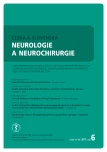-
Medical journals
- Career
Cognitive and Emotional Changes Five Years after SAH – a Case Report
Authors: J. Koblihová 1; M. Preiss 2; D. Netuka 3; L. Bernardová 3; V. Beneš 3
Authors‘ workplace: Ústřední lékařsko-psychologické oddělení, ÚVN Praha 1; Psychiatrické centrum Praha, University of New York in Prague 2; Neurochirurgická klinika 1. LF UK, IPVZ a ÚVN Praha 3
Published in: Cesk Slov Neurol N 2011; 74/107(6): 700-704
Category: Case Report
Overview
A five-year case study of a male patient after subarachnoid haemorrhage and treatment of intracranial aneurysm using endovascular technique is presented. The patient was at risk of severe complications of subarachnoid haemorrhage. Nevertheless, the final outcome was judged as favourable. We select relevant psychological and health status information derived from three psychological assessments (14 days after surgery, one year later, five years later). Negative cognitive and emotional changes do not concur with predictions made by the neurosurgeons. This case study reveals a complicated long-term development with functional disability in the field of work (return to employment in 3–4 years) and an increase in interpersonal problems within the family. This case study demonstrates the difference between neurosurgical and psychological evaluations and stresses the importance of psychological examination and care in patients after subarachnoid haemorrhage.
Key words:
SAH – coiling – psychological assessment
Sources
1. World Health Organisation. International classification of impairments, disabilities and handicaps. A manual of classification relating to the consequences of disease. Geneva: WHO 1980.
2. Egge A, Waterloo K, Sjøholm H, Ingebrigtsen T, Forsdahl S, Jacobsen EA et al. Outcome 1 year after aneurysmal subarachnoid hemorrhage: relation between cognitive performance and neuroimaging. Acta Neurol Scand 2005; 112(2): 76–80.
3. Bornstein RA, Weir BK, Petruk KC, Disney LB. Neuropsychological function in patients after subarachnoidal hemorrhage. Neurosurgery 1987; 21(5): 651–654.
4. DeLuca J. Cognitive dysfunction after aneurysm of the anterior communicating artery. J Clin Exp Neuropsychol 1992; 14(6): 924–934.
5. Hütter BO, Gilsbach JM, Kreitschmann I. Quality of life and cognitive deficits after subarachnoid haemorrhage. Br J Neurosurg 1995; 9(4): 465–475.
6. Preiss M, Koblihová J, Netuka D, Klose J, Charvát F, Beneš V et al. Kognitivní deficit po léčbě intrakraniálních aneuryzmat. Cesk Slov Neurol N 2007; 70/103(1): 37–42.
7. Hunt W, Hess R. Surgical risk as related to time of intervention in the repair of intracranial aneurysms. J Neurosurg 1968; 28(1): 14–20.
8. Teasdale GM, Drake CG, Hunt W, Kassell N, Sano K, Pertuiset B et al. A universal subarachnoid hemorrhage scale: report of a committee of the World Federation of Neurosurgical Societies. Neurol Neurosurg Psychiatry 1988; 51(11): 1457.
9. Fisher CM, Kistler JP, Davis JM. Relation of cerebral vasospasm to subarachnoid hemorrhage visualized by computerized tomographic scanning. Neurosurgery 1980; 6(1): 1–9.
10. Natarajan SK, Sekhar LN, Ghodke B, Britz GW, Bhagawati D, Temkin N. Outcomes of ruptured intracranial aneurysms treated by microsurgical clipping and endovascular coiling in a high-volume center. AJNR Am J Neuroradiol 2008; 29(4): 753–759.
11. Salthouse TA. Psychological Corporation. WAIS-III, WMS-III. Technical Manual. San Antonio: TX 1997.
12. Preiss M, Koblihová J, Krámská L, Dušánková E, Netuka D, Bernardová L et al. Kvalita života u pacientů po subarchnoidálním krvácení – roční katamnéza. Cesk Slov Neurol N 2008; 71/104(3): 309–316.
Labels
Paediatric neurology Neurosurgery Neurology
Article was published inCzech and Slovak Neurology and Neurosurgery

2011 Issue 6-
All articles in this issue
- Surgical Treatment of Brachial Plexus Injury
- Questionnaires of Activities of Daily Living in Patients with Alzheimer Disease
- Parkinsonian Phenotypes – towards New Nosology of Atypical Parkinsonian Syndromes
- Updated Insight into the Pathophysiology of Migraine – an Update
- Motor Aspects of Speech Imparment in Parkinson‘s Disease and their Assessment
- Tractography in Neuronavigation during Intraaxial Brain Tumour Surgery Near Corticospinal Tract
- Amendment of the Czech Addenbrooke’s Cognitive Examination (ACE-CZ)
- Miller Fisher Syndrome – Four Case Reports and Review of Current Concept
- Parkinson’s Disease with a Phenotype of Progressive Supranuclear Palsy – a Case Report
- Cognitive and Emotional Changes Five Years after SAH – a Case Report
- Amisulpride in the Treatment of Schizophrenia
- The Reasons and the Process of Amendment of the Czech Addenbrooke’s Cognitive Examination (ACE-CZ)
- Postural Reflexes in Conditions of Visual Disturbance
- Extension of the Therapeutic Time Window for Intravenous Thrombolysis Should Not Lead to Prolongation of Door-to-Needle Time
- Czech and Slovak Neurology and Neurosurgery
- Journal archive
- Current issue
- Online only
- About the journal
Most read in this issue- Miller Fisher Syndrome – Four Case Reports and Review of Current Concept
- Updated Insight into the Pathophysiology of Migraine – an Update
- Surgical Treatment of Brachial Plexus Injury
- Amendment of the Czech Addenbrooke’s Cognitive Examination (ACE-CZ)
Login#ADS_BOTTOM_SCRIPTS#Forgotten passwordEnter the email address that you registered with. We will send you instructions on how to set a new password.
- Career

